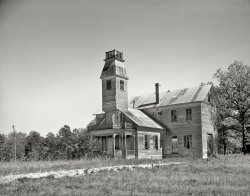
MAY CONTAIN NUTS

Search Shorpy
SHORPY ART

Framed or unframed, desk size to sofa size, printed by us in Arizona and Alabama since 2007. Explore now.
Join and Share
Ad-Free Shorpy
Shorpy is funded by you. Patreon contributors get an ad-free experience.
Learn more.

Recent comments
- Baldwin 62303
- Baldwin VO-1000
- Cold
- No expense spared
- Tough Guys
- Lost in Toyland
- And without gloves
- If I were a blindfolded time traveler
- Smoke Consumer Also Cooks
- Oh that stove!
- Possibly still there?
- What?!?
- $100 Reward
- Freeze Frame
- Texas Flyer wanted
- Just a Year Too Soon
- WWII -- Replacing men with women at the railroad crossing.
- Yes, Icing
- You kids drive me nuts!
- NOT An Easy Job
- I wonder
- Just add window boxes
- Icing Platform?
- Indiana Harbor Belt abides
- Freezing haze
- Corrections (for those who care)
- C&NW at Nelson
- Fallen Flags
- A dangerous job made worse
- Water Stop
Member Photos
The Shorpy
Print Emporium
Print Emporium
Search Shorpy
Search results -- 30 results per page
- Family Business: 1943
- ... for the ironic necktie. Medium format acetate negative by John Vachon for the Office of War Information. View full size.
Items I ... Posted by Dave - 10/14/2015 - 11:36am -
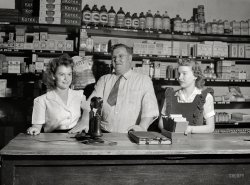
- Bob's Log: 1943
- ... requires all truck drivers to keep time records." Photo by John Vachon, Office of War Information. View full size.
Trailer Brake Lever ... Posted by Dave - 07/23/2013 - 5:55pm -
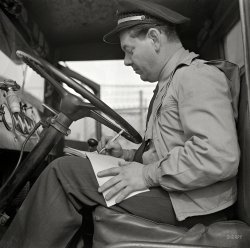
- Commuter Parking: 1937
- ... Resettlement Administration. 35mm negative by John Vachon. View full size.
Oh, the Old Days Wish the kids now days knew ... Posted by Dave - 08/13/2013 - 3:38pm -
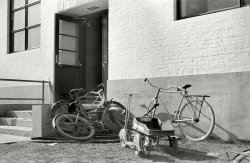
- Iron Man: 1941
- ... four hundred feet deep." Medium format safety negative by John Vachon for the Farm Security Administration. View full size.
Grand ... Posted by Dave - 05/17/2014 - 11:40pm -
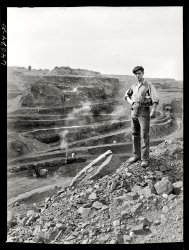
- Eggerss-O'Flyng: 1938
- ... yard, Omaha, Nebraska." Medium format acetate negative by John Vachon for the Farm Security Administration. View full size.
Reclining ... Posted by Dave - 08/08/2020 - 10:15am -
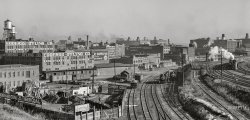
- Cream Poultry Eggs: 1938
- ... 1938. "South Omaha, Nebraska." 35mm nitrate negative by John Vachon for the Resettlement Administration. View full size.
Cryptogram? ... Posted by Dave - 08/02/2017 - 9:25am -
![Cream Poultry Eggs: 1938 November 1938. "South Omaha, Nebraska." 35mm nitrate negative by John Vachon for the Resettlement Administration. View full size.
Cryptogram?NSA Alert: strange sequence of numbers above door which contains "strange" for sale sign.
[5037, 5039, 5041 ... almost like an address of some sort! - Dave]
Re: Cryptogram?I think those are the letters "SO", not numbers. The others numbers would be the addresses of the store and the two houses behind it, perhaps? The "SO" could possibly designated "South."
[As noted below, 5037-39-41 are the building's three street addresses: 5037, 5039 and 5041 24th Street. - Dave]
Baby ChicksFor pets or for eating. OK, it doesn't say that here, but one day while motoring along a Pennsylvania country road in my Healey 3000, I came upon a sign that read: "Baby rabbits. For pets or for eating." Just wanted to share that.
Package CoalI looked up Staley Feeds and found some interesting info. Tint-sax were feed sacks in various pastel colors with a higher quality cloth. The company became aware that farmers wives were dyeing the feed bags and using them to make clothing for the family. The colored sacks meant to appeal to the wives. As well, Staley Feeds introduced high-fructose corn syrup to us.
Super ThriftThe building now houses St. Vincent DePaul Super Thrift Store at 5037 South 24th Street in Omaha.
View Larger Map
"Baby Chicks"I guess that's another way of saying "eggs."
Buildings that changeThe cool thing about these buildings is that the houses (boarding?) in the rear were constructed first between 1880-1905, then the zero lot line commercial storefronts were probably constructed in the late 1920s - mid 1930s.
These kinds of "hybrids" are all over America on the edges of historic business districts. Some just have storefronts built in the front yard; some houses were lifted and the dirt excavated for a new lower story.
Early examples of adaptive reuse as well as buildings that show physical traces of the development history of neighborhoods. Love it!
(The Gallery, John Vachon, Omaha, Stores & Markets)](https://www.shorpy.com/files/images/8a03870a.thumbnail.jpg)
- Home Plate: 1941
- ... at Erie, Pennsylvania." Medium format acetate negative by John Vachon. View full size.
No coffee mugs here. I don't think anyone ... Posted by Dave - 02/10/2021 - 4:26pm -
![Home Plate: 1941 June 1941. "Wife of defense worker setting table for dinner in trailer home. Trailer camp at Erie, Pennsylvania." Medium format acetate negative by John Vachon. View full size.
No coffee mugs here.I don't think anyone uses saucers under coffee cups any more. Am I wrong?
The dish with the dishesShe's a cute lady; reminds me of Lee Remick. It's clear that she cares about setting the table for the meal, even though she needs to straighten out that silverware. Speaking of ware, I wonder if the dishes are Fiesta.
And RDown3657 is correct; it's all mugs now, at least in my world and the world of everyone I know. My coffee cups and saucers -- stacks of them -- that match my dishes, are on the highest shelf of the cupboard and are never used. My eclectic mug collection is prized, however, and my guests have a wide range from which to choose at coffee serving time.
HarlequinIt’s not Fiesta but close - those are Harlequin dishes, the lower priced siblings of Fiesta, also made by Homer Laughlin
What's for desert Mom?Family weekday dining in our household enlisted the saucers to function as desert plates. Fewer dishes for me to dry!
[Perfect for that cactus ice cream. - Dave]
Harlequin dishesThe dishes are not Fiesta, which had more rounded coffee cups. They are likely Harlequin, which was made by the same company, Homer Laughlin.
http://www.laurelhollowpark.net/hlc/harlequin-p2.html
Fine DiningGetting a good defense job at a time when jobs were still fairly scarce AND a nice trailer to live in to boot seems like something worth celebrating! She's taking such pride in setting the table. And by the way the light is shining off of that spoon and knife, they appear to be real silver! I hope they had a great meal and a happy life!
Dishes I.D.You're on the right track, JennyPennifer, the dishes are younger siblings of Fiesta, in this case the Harlequin pattern, introduced in 1938 as another product of the Homer Laughlin Pottery Co.. The Harlequin pieces are generally slightly smaller and lighter in weight than Fiesta, and were less expensive when they were originally sold in F.W. Woolworth ten-cent-stores. Harlequin did share Fiesta's Art Deco style, as they were also designed by Fredrick Rhead. Harlequin came in some different colors from Fiesta, including a striking mauve shade of blue.
Many thanks, everyonefor all of the excellent information on the dishes. I wish I had some of them now. I especially love the way that, in the Harlequin ad, they mis-matched the colors on the cups and saucers. I would totally do that. I remember when, growing up, a lot of our mismatched collection of dishes -- and dish towels to dry them with -- came out of soap powder and oatmeal (Crystal Wedding) boxes. I believe Homer Laughlin did a promotion like that too, with Carnival ware, but it was before my time.
(The Gallery, John Vachon, Kitchens etc.)](https://www.shorpy.com/files/images/SHORPY-8c19254a.thumbnail.jpg)
- Ott's Esso Arboretum: 1937
- ... this was a thing back then. Medium format negative by John Vachon. View full size.
Feat of clay Love the fancy brickwork in the ... Posted by Dave - 02/27/2013 - 8:30am -
![Ott's Esso Arboretum: 1937 July 1937. "Gas station in Washington, D.C." Ott's Esso Service, providing our second example in as many weeks of gas-station faux flora. Maybe this was a thing back then. Medium format negative by John Vachon. View full size.
Feat of clayLove the fancy brickwork in the road.
TriangulationCan anyone roughly pinpoint the location of this gas station based on the distances to the cities on the chart?
["Roughly pinpoint" -- phrase of the day! - Dave]
One-Stop ServiceOtt's Service Station was located at 12th and H Streets N.W. but branch locations included 923 H St. N.W., 7th and Rhode Island Ave. N.W, and Sherman Ave. and Park Rd. N.W. The corner at 12th and H has been entirely rebuilt since 1937 which challenges the ability to definitively connect this photo with that location.
[As indicated by the sign on the mural, the name of the business was Ott's Service Stations, plural, with every station being a "branch." - Dave]
I am in total agreement with stevendm on the impressive craftsmanship of the paved street stonework.
Hopefully some DC historical trolley buff might be able to collaborate one of the above locations of Ott's Service Stations with the location of tracks along a route of the 1930s streetcar system.
Gas artReminiscent of gas station road maps of the period, like this one that's been in our family since the year one, as my mother would say.
Doing it rightThere's so much to love in this shot: the two attendants (the guy with no coin changer is probably in training) in the middle of the photo just waiting for their next customer, the (rare) convenient soda bottle machine (certainly 5 cents per 6-oz. bottle) next to the pumps, and the helpful "distance to" signs on the back wall.
And what IS that four-story building where the mural is painted? The gas station office is apparently on the right side, where all the action is.
Wonderful slice of life from an era where a fill-up probably cost 85 cents.
[The other "attendant" is wearing mechanic's coveralls. - Dave]
Coin changerA classic from the days when every transit operator carried and received and processed cash. The metallic sound of it was hypnotic, more so in the hands of a skillful and experienced change-maker. I had one of my own at home and would gladly make change for anyone who asked. Still made by a company named McGill, in Illinois.
LocationThis looks like it might be on Wisconsin Avenue in Georgetown, maybe around P or Q Streets.
So much to seeLaundry out on several clothes lines drying. A couple of great looking convertibles, especially the car on the left side street. The rumble seat open on the other, and it with no windshield! The the fellow looking under the coupe on the far right. And finally the person on the 3rd floor shaking out their throw rug from the window. All at 4:45 PM on another typical summer day!
Re: TriangulationBased on the mountain at the back of the picture (which by the way looks strangely like the Paramount Pictures logo), I'd guess we could "roughly pinpoint" the location to exactly somewhere on Planet Earth; more or less.
It's at the corner of what and what?I knew this photo looked familiar. That nifty book of vanished DC, "On This Spot," lists this station as being located at 36th and M Streets NW, over in Georgetown. (Page 194 for those of us that want to check). Given the incline of the street seen at the left side of the photo, and streetcar tracks embedded in the street in the foreground, this seems a likely location.
[There were numerous Ott Esso stations in the District. - Dave]
Not streetcars or trolleysThe fact that there are 3 'rails' reveals that this is a cable car system of the type that still runs in San Francisco.
[Most of the system was electrically powered. Streetcars got their juice through a "foot" that ran in the center groove. - Dave]
30th & M Street?Based on this image from the DDOT library it could be the corner of 30th and M Streets.
(The Gallery, D.C., Gas Stations, John Vachon)](https://www.shorpy.com/files/images/SHORPY_8b29417a.thumbnail.jpg)
- Bleak House: 1940
- ... County, North Dakota." Medium format acetate negative by John Vachon for the Farm Security Administration. View full size.
Pipe ... Posted by Dave - 12/18/2019 - 10:54am -
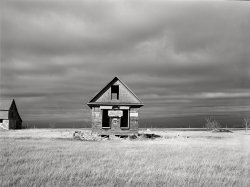
- Granitine: 1942
- ... Home of the Granitine Laundry Tray. Acetate negative by John Vachon for the Office of War Information. View full size.
Two Wringer ... Posted by Dave - 08/16/2021 - 9:56am -
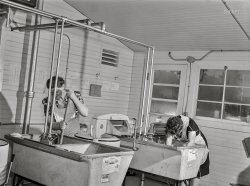
- Street Life: 1941
- ... Pennsylvania." Medium format acetate negative by John Vachon for the Farm Security Administration. View full size.
Is that ... Posted by Dave - 06/07/2020 - 4:05pm -
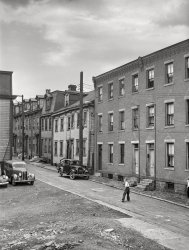
- The Bros of Summer: 1941
- ... Crossing, Michigan." Medium format acetate negative by John Vachon. View full size.
Since I'm not that old I have a ... with smoke and beer and that was all.
(The Gallery, John Vachon, Small Towns) ... Posted by Dave - 04/04/2020 - 3:10pm -
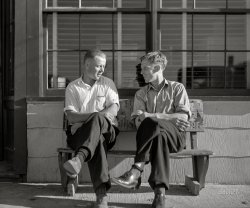
- Winona Flour: 1940
- ... House of David religious community." Acetate negative by John Vachon for the Farm Security Administration. View full size.
You Needa ... Posted by Dave - 12/10/2019 - 10:39am -
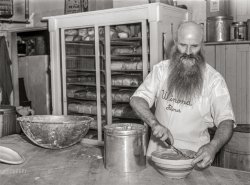
- Spring Rollers: 1941
- ... Portsmouth, Virginia." Medium format acetate negative by John Vachon. View full size.
What a flashback I recognize those houses! ... Posted by Dave - 01/06/2020 - 2:22pm -
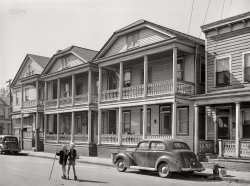
- Real [Blank] Spaghetti: 1940
- ... the word ITALIAN has been painted over. 35mm negative by John Vachon for the Farm Security Administration. View full size.
You might ... Posted by Dave - 11/20/2011 - 6:30am -
![Real [Blank] Spaghetti: 1940 November 1940. "Greek restaurant in Paris, Kentucky." Mussolini's Fascist regime has just invaded Greece, and the word ITALIAN has been painted over. 35mm negative by John Vachon for the Farm Security Administration. View full size.
You might think all spaghetti was ItalianBut my ex mother-in-law made spaghetti sauce using Campbell's tomato soup with Velveeta cheese and bologna. This was circa 1955 in Lexington. Kentucky was and is nice (I went to U of Ky), but Connecticut is better for Italian food.
First we stop at Nick'sfor a plate of unknown spaghetti, then next door to pick up a new Chevy.
Real Spaghetti SandwichesYum! I bet those are good sandwiches. After lunch I think will go and buy a Hevrolet.
Axis powerWhy would they black out "Italian." Perhaps it has something to do with the run-up to WWII.
[Perhaps it was WWII itself, and the caption explains it. - Dave]
Childhood RhymeWhistle while you work,
Hitler is a jerk,
Mussolini
Is a meanie,
Whistle while you work.
As for the "real spaghetti sandwiches," we actually had a kid in our class who brought those from home for lunch as most families had little meat. Also sardine sandwiches, plain mayonnaise sandwiches, etc. I kind of like going back to the 40's since even after 70+ years I still remember those friends and conversations. I have read that your childhood friendships were the real thing because little kids have not developed the phoniness, social obligations, artificiality or opportunism persona, but accept each other at face value. I miss my old friends, but I digress, I'll shut up now.
LSMFT in the '40s"Lucky Strike Means Fine Tobacco." It also could mean "Lord Save Me From Truman." Heard it both ways many times in the late '40s and early '50s.
No Italian spoken hereMy stepsister, who was Icelandic, spoke Italian. We lived in the U.S. from 1941 to 1944, when she was 7-9 years old, but she refused to utter a word in that language. I only spoke Icelandic and Danish, so I didn't have that problem.
I wish I still had my Hitler button. It had a string that brought Der Führer up with a noose around his neck when you pulled it. It was an interesting time for us kids, totally oblivious of the horrors of war, although we saw saw some action in October of 1941, when the convoy we were a part of was attacked by German subs. We didn't get hit, but we saw the Reuben James get it. Woody Guthrie wrote a song about that historic sinking.
Eating for successI know it is not the intent of the sign, however, I have had spaghetti sandwiches even recently. Best eaten on an Italian roll with smashed meat balls, a good sauce and sprinkled cheese. During the Depression, my mother took baked bean sandwiches to school. Other kids made fun, so she told them she loved baked beans so much that she asked her mother to make her lunch with them. Somehow, even hungry, the kids made it through and obtained a fine education. Now the kids get free school lunches - complain about them, and get lower test scores than ever. There must be a moral to learn there somewhere.
Rue Principale, Paris (KY)Nick's is now Charles' Barber Shop, and the Chevy dealership is an antique mall.
View Larger Map
Couldn't resist!Love the juxtaposition of old and new!
Mayo clinicNothing wrong with eating cheaply, so long as you're eating. When my dad was a student at University of Florida in the 1950s, his budget allowed him to eat mostly mayonnaise sandwiches. He never complained that he despised it though -- he still loves mayonnaise to this day.
(The Gallery, John Vachon, WW2)](https://www.shorpy.com/files/images/SHORPY_8a32712a.thumbnail.jpg)
- Twin Cities Trucker: 1939
- ... Minneapolis, Minnesota." Medium format acetate negative by John Vachon for the Farm Security Administration. View full size.
Pre ... Posted by Dave - 05/18/2020 - 1:17pm -
![Twin Cities Trucker: 1939 September 1939. "Truck driver who operates between Twin Cities and radius of 150 miles tying in load. Minneapolis, Minnesota." Medium format acetate negative by John Vachon for the Farm Security Administration. View full size.
Pre Aerosol Graffiti I see the street artist of the time had to use sidewalk chalk for their tagging. Or, are those rail hobo telegraph messages?
[Routing designations scrawled by railyard switchmen. -Dave]
Independent TruckerThis is a good example of how independent owner-operated trucking worked back then. Licensed and regulated trucking companies and union drivers would have referred to him as a "gypsy."
If you had a large enough freight shipment, it would be much cheaper to just "rent" a boxcar from the railroad and be responsible for loading and unloading it yourself. The railroad would park the car on a "public" or "team" track, and you would "release" it to the railroad when it was loaded and ready to move, and when unloaded at the destination and available for reassignment. You had a limited time to hold the car at each end without incurring extra charges called "demurrage." You could save even more by having a one-person delivery service like this one to unload it for you if you couldn't do it yourself.
My great-grandparents used this method circa 1895, when they moved 75 miles from Darlington to Columbia, South Carolina. It was the only way to do it then, since roads (and trucks) did not yet exist.
Safety CabWhen your brakes are unreliable, it's important to be able to jump out quickly!
Thisis N.P.R.
Trucker's Hitch?I'm curious how the tension on this load is maintained. Is it possible that a "trucker's hitch" is applied on the opposite side of the vehicle?
Insulation for Minnesota wintersThese are Gimco rock wool insulated batts. Rock wool has traditionally been made by melting down basalt stone and recycled slag from steel mills.
Interesting article about it here:
https://www.familyhandyman.com/walls/mineral-wool-insulation-is-making-a...
He's got a story to tellIf only he could tell about that time he lost the cab's door.
ToastyI'm sure that new Minnesota homeowners will appreciate those "Full Thick Sealal Bats" come wintertime.
Old boxcarsA couple of elderly cars for a 1939 photo. Believe it or not, the one on the right is probably older -- you can see the metal “truss rods” under the floor of the car, a tensioning system to strengthen the wood floor. Unless it had steel members added, most of that car’s structural members are probably wood, while the car on the left lacks the truss, and probably has a steel underframe.
I love the arched “Northern Pacific” lettering -- the kind of thing that vanished as wages rose, because it was harder to do with a single stencil.
(The Gallery, Cars, Trucks, Buses, John Vachon, Minneapolis-St. Paul, Railroads)](https://www.shorpy.com/files/images/SHORPY-8c16935a1.thumbnail.jpg)
- This Old Stove: 1940
- ... in her kitchen." Medium format acetate negative by John Vachon. View full size.
This Old Everything The stove isn't the only ... Posted by Dave - 12/07/2019 - 11:23am -
![This Old Stove: 1940 July 1940. Door County, Wisconsin. "Wife of Farm Security Administration rehabilitation borrower in her kitchen." Medium format acetate negative by John Vachon. View full size.
This Old EverythingThe stove isn't the only old thing. Everything, including the house looks old and well worn. This was back in the day when things were used in perpetuum and not discarded because they looked old or out-of-fashion. Today's generation would cringe seeing how their not-too-distant ancestors lived. I'd wager to bet, though, that great Aunt Myrt lived a happier life.
I'll betIt was real sense of accomplishment after mastering how to cook a whole meal on a wood stove like this one. There are so many different cooking areas, dampers and vents. I can imagine each area effecting the one next to it so it would be constant adjusting of the vents.
I have trouble with an electric stove.
[Although you could burn anything you wanted in them, most of these stoves (this particular model is a Ringen "Quick Meal" range) were fired by coal. - Dave]
To many combustibles nearbyNewspapers and a motor oil can. Coal in the washtub I imagine. Oil on the floor Oh Boy. Looks downright dangerous.
Love Door CountyGrowing up in Chicago in the 1970s, a camping trip to Door County was a treat. The skinny "thumb" of the state that projects into Lake Michigan, Door County is/was staggeringly beautiful, and very remote. But that was 30 years ago so maybe it's all strip malls now?
Hot Oil?Storing a possibly leaking gallon can of motor oil next to a hot stove doesn't seem like a good idea.
A Special Gourmet TouchFrench fries cooked in motor oil.
DangerThis looks like an instructional 'Do Not Do This' photo. The can of motor oil and loose newspapers next to the stove and the rags/cloths hanging above are a fire disaster waiting to happen.
Green Bright Motor OilMakes for smooth eating, helps keeps you regular!
Decoration and maker's prideI'm always amazed about the extra work they put into decorating items even like that stove. After all, all those leafs, scrollwork and other reliefs did not serve any other purpose that being pretty (as seen at the time).
And somebody still had to design that decoration, some workers had to model them, and they may have taken some extra metal. Not much when compared to the whole product, but somebody had to be paid for it.
And it added up with mass production. I guess those stovs were sand-molded cast iron? Imagine the engine block of your typical V8 being embellished with scrolls and leaves.
Safety FirstNothing says responsible home safety practice like having a leaky can of motor oil leaning against your blazing hot cast iron stove. Extra points for the straw broom fallen over and coming very close or touching the stovepipe, and tub full of flammable rags immediately adjacent.
Corny Cookin'My Great Aunt Nettie made some wonderful meals on a very similar stove on a farm just outside Sidney Ohio. She fired her stove with dried corncobs. Nothing went to waste on the farm!
Gas is betterI had family in the anthracite coal region of Pennsylvania. In addition to cooking, the coal stove heated water for the whole house, and was also the primary source of heat in the winter. It was lit every day of the year, and needed attention keep going. A weekend away meant the ordeal of relighting it. Then there was carrying coal up from the basement, the ashes out to the can near the street, etc. This went on into the early 1970s.
No Sleeves RequiredI'm guessing even if this wasn't summer, she could still get by with short sleeves once this thing got heated up.
(The Gallery, John Vachon, Kitchens etc.)](https://www.shorpy.com/files/images/SHORPY-8c17757a.thumbnail.jpg)
- The Shoe Line: 1943
- ... Line at rationing board." Medium format negative by John Vachon for the Office of War Information. View full size.
Good Grooming ... Posted by Dave - 09/13/2011 - 7:23pm -
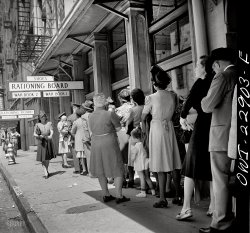
- The Happy Homemaker: 1940
- ... and papered the wall herself." Medium format negative by John Vachon for the Resettlement Administration. View full size.
Wow! All ... Posted by Dave - 12/06/2019 - 12:35pm -
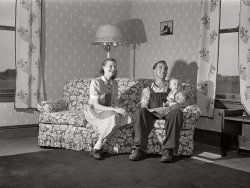
- The Wall: 1941
- ... going up on the other side." Acetate negative by John Vachon. View full size.
New look The wall still stands, mostly ... Posted by Dave - 06/21/2020 - 7:22pm -

- Hatty's Hats: 1943
- ... the garment district." Medium format nitrate negative by John Vachon for the Office of War Information. View full size.
Now and Then ... Posted by Dave - 06/26/2014 - 10:42am -
![Hatty's Hats: 1943 March 1943. "New York. Trucks in the garment district." Medium format nitrate negative by John Vachon for the Office of War Information. View full size.
Now and ThenGarment center is now mostly farther west.
View Larger Map
Governor Clinton Hotel - 1962At the age of 8, I stayed with my family in the Governor Clinton Hotel, and was fascinated looking out the window at the men pushing racks of clothes down the street wreathed in clouds escaping steam.
What is the nameon the trailer on the left? It looks like FREUHAUF or is the last letter an R? Freuhauf is the current name so I expect it is an F
Looking at these pictures I find it interesting how long some brand names have been around.
[Fruehauf Trailer Co. was in business from 1918-1997. -tterrace]
Millinery DistrictWest 36th Street in this area was part of the Millinery District. A subset of the larger Garment District, the Millinery District ran between Fifth and Sixth avenues and from 35th to 40th streets. During its heyday in the 1920's it housed over 600 hatmakers with a total of 15,000 employees. It already was in decline by 1943, and today only a few specialty hat businesses remain. The name is still commemorated by the Millinery District Synagogue on Sixth Avenue between 38th and 39th streets, though being on the west side of Sixth the temple is actually just outside the district's boundaries.
Railway ExpressThe fourth and fifth trucks in line appear to be Railway Express trucks, the UPS or FedEx of the day. At least they didn't park in the middle of the street like modern delivery services do.
The semi on the leftI just love the appearance of that semi on the left. What make was it?
InternationalThe first truck on the left hauling the Fruehauf Trailer looks like a 1941 - 1943 International. Most likely it is a 1941, but some civilian truck production continued throughout the war in order to help move goods to market. The model may be a 5-Ton K-8 which was very popular. This model " . . . used a Red Diamond 318 engine and a five speed overdrive transmission with single or double reduction axles (K-8, KR-8) or a two speed axle (KS-8)." The windshield still opened up at the bottom to allow additional ventilation in the cab.
Source: International Trucks by Frederick W. Crimson, p. 170
(The Gallery, Cars, Trucks, Buses, John Vachon, NYC)](https://www.shorpy.com/files/images/SHORPY-8d26830a.thumbnail.jpg)
- Fourth and Main: 1941
- ... parade in Watertown, Wisconsin." 35mm nitrate negative by John Vachon for the Farm Security Administration. View full size.
Free ... Posted by Dave - 07/04/2012 - 2:54pm -
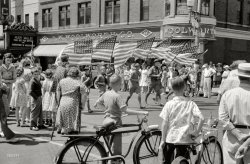
- Truck Museum: 1941
- ... where commission merchants sell to retailers." Photo by John Vachon, Farm Security Administration. View full size.
Bald tires! ... Posted by Dave - 08/02/2012 - 9:54pm -
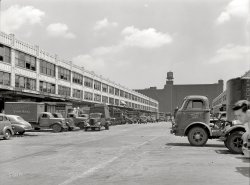
- Track Star: 1938
- ... Pacific yards. Omaha, Nebraska." Medium format negative by John Vachon for the Farm Security Administration. View full size.
UPRR ... Posted by Dave - 08/02/2017 - 9:22am -
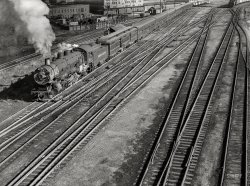
- Over Omaha: 1938
- ... among other attractions, Tri-City Barber College. Photo by John Vachon for the Farm Security Administration. View full size.
Found one! ... Posted by Dave - 06/24/2019 - 12:59pm -
![Over Omaha: 1938 November 1938. "Omaha, Nebraska." A bird's-eye view of, among other attractions, Tri-City Barber College. Photo by John Vachon for the Farm Security Administration. View full size.
Found one!The Ford Bros. building (in the upper right corner of the photo) still stands at the corner of Dodge & 11th streets.
Graybar Electrical SupplyContinues to thrive all over North America, and is still employee-owned.
An early Ford spottedOne of the billboards advertises the film "Submarine Patrol," which was directed by John Ford for 20th Century Fox, the last Ford-directed film before a run of seven box-office or critical successes in a three-year period that would make him a legend.
Much Has ChangedMy 1940 Omaha City Directory places the barber school at 1302 Douglas Street. Virtually everything in this photo is now gone.
Much Has Changed IndeedI'm glad EADG found the barber school at 1302 Douglas Street, because I found the Arcade Hotel at 1215 Douglas (reference: https://history.nebraska.gov/collections/arcade-hotel-omaha-neb-rg3870am). Since hlupak604 identified the Ford Bros. Van & Storage building still standing at Dodge and N 11th Streets that means this photo is looking north towards what is now Interstate Highway 480. The railroad tracks in this 1938 photo, almost every building, and the tall building from which this photo was taken (and is casting the shadow) are gone.
Yes pleaseSunshine Biscuits! Yay! I'll have a case of Hydrox cookies. And a visit to the Uptown Cafe too, after parking under cover for only 20 cents. Just sounds like a great time. What a fabulous picture. I scanned it for many minutes, as big as I could get it. This is why I love Shorpy: unvarnished but soulful glimpses of long-ago America.
It took me awhile to find oneDoesn't look like they had too many trees in the area back then
Strange place for a periodThe A.Y. McDonald Mfg. Co. has a period under the c in McDonald. I'm what is considered an old timer, and I had never seen this before today.
[Those glyphs (dots, triangles, dashes, etc.) under superscript letters are diacritics. - Dave]
Identity Theft?It is interesting to note that this 1938 scene includes a billboard touting the presumably-yet-to-be-released 1939 Chevrolet by means of an illustration that bears very little resemblance to the actual design. Could this have been an early version of fake news?
[As most everyone knows, Detroit’s model year begins in the fall or summer of the previous calendar year. And that is a faithful rendering of the 1939 Chevrolet. -Dave]
The '39 Chevy had a V-section grille, receding at the top, with a center strip. The illustration suggests a more LaSalle-like vertical curved prow -- reason to believe that the illustrators were working from a prototype or sketch of same.
[You're mistaken. And the photo is from November 1938. - Dave]
A.Y. McDonald Mfg. Co.An immigrant from Scotland, born in 1834, A. Y. McDonald opened his plumbing shop in Dubuque, Iowa, in 1856, making his company nowadays, at 163 years old, one of the country’s 100 oldest family businesses. It expanded to Omaha in 1915. The firm’s president is still a McDonald, great-great-grandson of the founder. A.Y. himself was in the Civil War, shot twice, and he was shot a third time, later in life, in a home invasion. He died in 1891 at the age of 57.
What a fascinating photo that rewards multiple and extended viewings. It all seems to be gone, as EADG points out, but if you google 1150 Douglas Street, outside the photo to the right, to the east of the Omaha Stove Repair Works (1206-8 Douglas), you can streetview a few old survivors, notably a three-story red-brick building marked Specht.
OopsHey, Dave, you're right! It appears that the photos I googled, in an attempt to make sure I knew what I was talking about, illustrate 1940 models. Now, as a kid I'd never have been fooled in that way. Thanks for engaging on this one!!!
Graybar Electrical Supply... has a fascinating story. "Gray" is Elisha Gray, the (alleged) inventor of the telephone, whose patent was scooped by Alexander Graham Bell. The company was spun off from Western Electric, the wholly-owned supplier to the Bell System.
https://en.wikipedia.org/wiki/Graybar
(The Gallery, John Vachon, Omaha)](https://www.shorpy.com/files/images/SHORPY-8b14209a.thumbnail.jpg)
- Free Parking: 1937
- ... 35¢: Vince, now just 29 cents. Medium-format negative by John Vachon. View full size.
Overstock? Seems like the good druggist may ... Posted by Dave - 04/19/2013 - 9:59am -
![Free Parking: 1937 September 1937. "Drugstore in Washington, D.C." Marked down from 35¢: Vince, now just 29 cents. Medium-format negative by John Vachon. View full size.
Overstock?Seems like the good druggist may have bought more feminine products than he had room for in the stock room.
I see Sal Hepatica is on sale. That company along with Ipana Toothpaste sponsored Fred Allen's Town Hall Tonight in the late '30s. "Ipana Toothpaste for the smile of beauty and Sal Hepatica for the smile of health!"
Those Modess BoxesEastman Kodak also provided oversize film boxes for use in drug store display windows. I suspect that the Modess advertising department had the same idea.
Modess-becauseDoes anyone remember the ads for this product in 1950s and 1960s women's magazines, like McCall's and Ladies Home Journal? They featured a photo of a glamorous fashion model dressed in a designer gown, standing on the balcony of a Mediterranean palazzo, gazing at the stars. Below the photo was the line, "Modess-because." At the age of 6 or 7, I had no idea what they were advertising, but if you got to wear a dress like that, I wanted to buy it! A few years later, I discovered that the reality was MUCH less glamorous.
Re: Times have changedIn the first summer of my life, in 1958 in Winnipeg, my mother would leave me in a carriage outside the neighbor's window while she went downtown. If I cried or fussed, the neighbor would hear and tend to my needs. (This is the story I was told.)
Someday I'll Find YouMr. Keen Tracer Of Lost Persons, brought to you on this CBS Radio Station by Kolynos Toothpaste. The headline was the show's theme song. It was on the air from 1937 through 1955.
Young MickeyOn display is an Ingersoll Mickey Mouse watch for 3.25. You can get one on eBay for about that much today!
Kind of surprisedto see Modess prominently displayed in the front window like that. And what's that bottle cap doing there on the sidewalk? A possible refugee from a game of Skellies?
Good Hope Road?I'm guessing this was somewhere on Good Hope Road, SE, which runs from what was then Nichols Avenue, and Naylor Road, or maybe Alabama Avenue.
Times have changedToday it would be completely unthinkable (not to mention illegal), but back in this photo's era it was quite routine for a parent to leave an infant outside in the carriage while the parent went into a store.
So what WAS Vince?Or, what IS Vince? Never heard of it.
And there's no reason to google it since so many Shorpy-ites probably know the answer already.
[Class? Anyone...? Anyone...? -tterrace]
My guessVince Tooth Powder
[A definite possibility! -tterrace]
Ice Cream!I have Googled and searched, but can not make out the brand of ice cream. It does seem to have some type of AAA approval!
[Wadrex Ice Cream was a brand name owned by Colonial Ice Cream Co. of Washington, D.C. -tterrace]
Tony's PlaceGood Hope Pharmacy was located at 1400 Good Hope Road, S.E. The pharmacy survived till the 1960s. It looks to be the same building today. Later uses include the Southeast Neighborhood Action Board (1970s), a methadone clinic (1980s), and Good Hope Seafood (1990s).
View Larger Map
Babies receiving benign neglectDavidK, your comment hit home with me - my first summer was also in 1958, and my parents were building an addition to our house. They parked my carriage under a shade tree, and the neighbor lady would come and get my Mom if she heard me crying too much! Times were different, indeed.
Prams in East BerlinWe were in Germany for the last three years before the Berlin Wall came down. Being a military family, at the time, we had special privileges there. One thing I noticed right away was all of the baby carriages parked outside of stores. Most of them had the babies still in them. In the 80s, no one in American, or even in West Germany, would have left babies unattended. But, there were a few advantages over there and one was a low crime rate, so people were safe leaving their babies alone in their prams while they went inside to shop. Of course, there were also many disadvantages to living there. I know that people in some parts of America did that, at one time.
Child abandonmentThose who grew up in the 1950s and before were left outside on the pavement in our strollers or prams whenever our mothers shopped. As well, it was considered very healthy for a baby to sleep out in the pram, even on brisk days, well wrapped up. Not just for general health but to prevent Tuberculosis.
When I was crawling, my mother also put me out in the back yard in my harness which was tied to a large screw into the lawn so I couldn't wander off. She would come out periodically to check on me and to move my toys back into reach.
Leaving the children out unattended in the pram stopped after the time when we went to the local indoor swimming pool one sunny summer day in 1964. My mother pushed the stroller in under the shrubbery with my baby sister, just a few weeks old, in it and started up the stairs. I was horrified! I made a big fuss because I was worried someone would steal her. "Who would do THAT?" My mother asked. I made such a stink that my mother went and got my sister and brought her inside with us.
When we came out, we discovered that there had been a flash rainstorm and the pram, one of those deep British ones, was full to the brim with water. Neither of us said a word but neither me sister or my brother who followed two years later was ever again left alone in the pram.
(The Gallery, D.C., John Vachon, Stores & Markets)](https://www.shorpy.com/files/images/SHORPY_8b31477a.thumbnail.jpg)
- Little Boy Blue: 1941
- ... the Ford bomber plant." Medium format acetate negative by John Vachon for the Farm Security Administration. View full size.
Below ... Posted by Dave - 03/18/2020 - 2:44pm -
![Little Boy Blue: 1941 August 1941. "Son of Mr. Nichols, defense worker from Cass City, Michigan, now living in a trailer at Edgewater Park near Ypsilanti. Mr. Nichols works in the Ford bomber plant." Medium format acetate negative by John Vachon for the Farm Security Administration. View full size.
Below decksThe very best in the design of yacht interiors. Oh, it’s a trailer? Whatever. And such beautiful grain in the plywood. And a cute (albeit sad) kid.
Sit this wayThe reason the boy is sad is likely from the task of having to follow the directions of the photographer and his mother. He probably hated the whole ordeal and just couldn’t wait to get back outside and play where there were no adults. Poor lad.
The Shadow knowsthat all you need for mystery and suspense is a small breeze and a warm radio.
The thing above the valanceMany RVs from the 60s on have built-in entertainment systems, but I've never seen a pre-war unit with one. If that's what it is, then the small bakelite radio below is like what I remember from many basements in the 70s: a small TV, set atop a larger wood cabinet TV that had stopped working.
What is that top dial?I see the bottom table top radio but what is that top dial about?
Don't touch that dial!The interesting thing here is that there is what appears to be another radio (or some other electronic equipment) directly above the while marble radio in the center. I cannot read the make or model for either the upper or lower device. Perhaps someone with expertise in radios of this era can identify them. The upper one looks to have several bands.
It's placed so high that the morose young man certainly cannot touch it, but it's also above what I expect would be the parents' comfortable reach as well. Also intriguing are the paper cards marked "RECEIVED" that are blocking the speaker grille. Does the radio still work?
Questionable designWhat's with the cabinet above the radio and fan? To the left: an instrument that's hard to read with 4 knobs that are hard to reach. To the right: an awkward place to store receipts.
Two radios doesn't make it stereo.They built an old Montgomery Ward Airline brand AM & shortwave band radio into the space above, but have a newer General Electric H-500 model AM-only radio on the counter.
That upper radioThanks Wiscojim for identifying the radios. You can see a see a nice picture of the GE H-500 here: https://www.radiomuseum.org/r/general_el_h500.html . As for the Montgomery Ward Airline, that is quite interesting. The Airline was a very long-lived brand - and was quite diverse, as you can see here:
https://radioatticarchives.com/archive.htm?page=a4#Airlin
Looking at the dial, the one here seems to be the closest match for the 62-196,
https://www.radiomuseum.org/r/montgomery_62_196_1.html
https://radioatticarchives.com/radio.htm?radio=5810
which was a rather handsome tombstone three-band unit before it was dissected.
Beetle GE General Electric H 500The Classic Radio Gallery informs us about the plastics used in radio cabinet construction. The GE H 500 radio, also known as the GE "Turbine", has a housing of Beetle plastic, a trade name used by the American Cyanide Cyanamide Co.
["American Cyanide"? Um, no. - Dave]
[Um, I see: do not quote without checking the quote itself, thnx Dave - Alex
(The Gallery, John Vachon, Kids)](https://www.shorpy.com/files/images/SHORPY-8c20120a.thumbnail.jpg)
- Plugged In: 1941
- ... defense workers. Aberdeen, Maryland." Acetate negative by John Vachon. View full size.
As Lily Tomlin once said Here at the phone ... Posted by Dave - 06/16/2020 - 7:47pm -
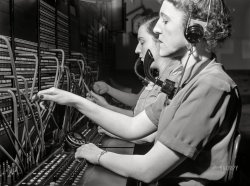
- Hollywood and Vine: 1939
- ... Wisconsin. "The week's bill." 35mm nitrate negative by John Vachon for the Farm Security Administration. View full size.
Poster ... Burns isn't mentioned. Interesting.
(The Gallery, John Vachon, Movies) ... Posted by Dave - 05/18/2011 - 9:53pm -
![Hollywood and Vine: 1939 September 1939. Cadott, Wisconsin. "The week's bill." 35mm nitrate negative by John Vachon for the Farm Security Administration. View full size.
Poster collectorsI checked some auction prices for these one-sheet movie posters, and came up with three:
Susannah of the Mounties $134 (2009)
Stronger than Desire $45 (2006)
Andy Hardy Gets Spring Fever $120 (2008)
The ringer is the Gracie Allen. I couldn't find any references or images of this particular design, but many for a different one whose estimates range up to $1700, so perhaps the one here is a real rarity.
"Vine." I get it.
LongevityMore than seven decades later, the stars of two of these movies are still among us: Mickey Rooney (going on 91) and Shirley Temple (83).
Stanley's Selection1939 was one of the greatest years ever for movies - i.e. Gone With the Wind, The Wizard of Oz, Dark Victory, Stagecoach, Mr. Smith Goes to Washington, Wuthering Heights, etc. - and the Stanley Theatre isn't showing even one of them!
Not Exactly First-RunAs with most small town movie houses, it looks like Cadott's Stanley Theatre was not very high up in the pecking order for new releases. According to IMDB, "Susannah of the Mounties" was released on June 13, 1939, "The Gracie Allen Murder Case" on June 2, "Stronger Than Desire" on June 30, and "Andy Hardy Gets Spring Fever" on July 21. Any Cadott residents who burned to see the latest movies might have made the nearly 100-mile trek to Minneapolis for quicker gratification.
Some of the hit movies mentioned below had been released in the Spring, but "The Wizard of Oz" didn't hit the screens until August 25 - sit tight, Cadott - and everyone was going to have to wait a bit longer for "Gone With the Wind." Although it premiered in December, it was not actually distributed to theaters until January 17, 1940.
Gracie Allen Murder CaseMy mother had a set of S.S. Van Dine's Philo Vance murder mysteries, gray covers with a spiderweb design. One of them was The Gracie Allen Murder Case. Philo was a rich guy of the "old boy, my dear chap" school whose valet assisted him in his investigations. I recall that many of the chapters began with epigrams in Latin or Greek and Philo was always tossing in "bon mots" in French.
Pre-TV WorldAs someone who has grown up in a post-television world, I find it fascinating how so many movies could be at one single screen theater over the course of 10 days. Hope you don't have any plans Tuesday night because that is the last night for "Susannah of the Mounties"!
On another note, what is a "bank-nite" and why is touted as being special?
[The signs say "Book Night." A promotional stunt dreamed up by exhibitor Robert Lippert. - Dave]
I did see that sign, but what I was referring to was written next to the Wed & Thurs above the Gracie Allen Murder Case poster.
Top BillingLewis Stone over Mickey Rooney
Gracie Allen over Kent Taylor
What were they thinking?
Now PlayingThe Stanley Theater is still open and playing films. I've had the pleasure myself, actually.
Daniel "Mussy" Eslinger and his family have been running the theater since 1968. In 2010, the family restored the outside of the theater to its 1936 glory.
The theater is a gem and so is Mussy. Where else can you get real butter on your popcorn?
Bank NiteBank Night (listed on the Wed-Thurs board as "Bank Nite") was a lottery for prizes which theaters held during the latter part of The Depression in order to get more patrons into their theater.
WallpaperThis picture would be the perfect 'wallpaper' for a fan of classical movies. I wonder if TCM has any of these flicks in their vault. I'd like to see the 'Gracie Allen' picture; note that George Burns isn't mentioned. Interesting.
(The Gallery, John Vachon, Movies)](https://www.shorpy.com/files/images/8a04849a.thumbnail.jpg)
- Jr. O.U.A.M.: 1938
- ... no longer "meets each 1st & 3rd Sat night." Photo by John Vachon. View full size.
Still a going concern. It looks they have ... Posted by Dave - 11/08/2012 - 11:48am -
